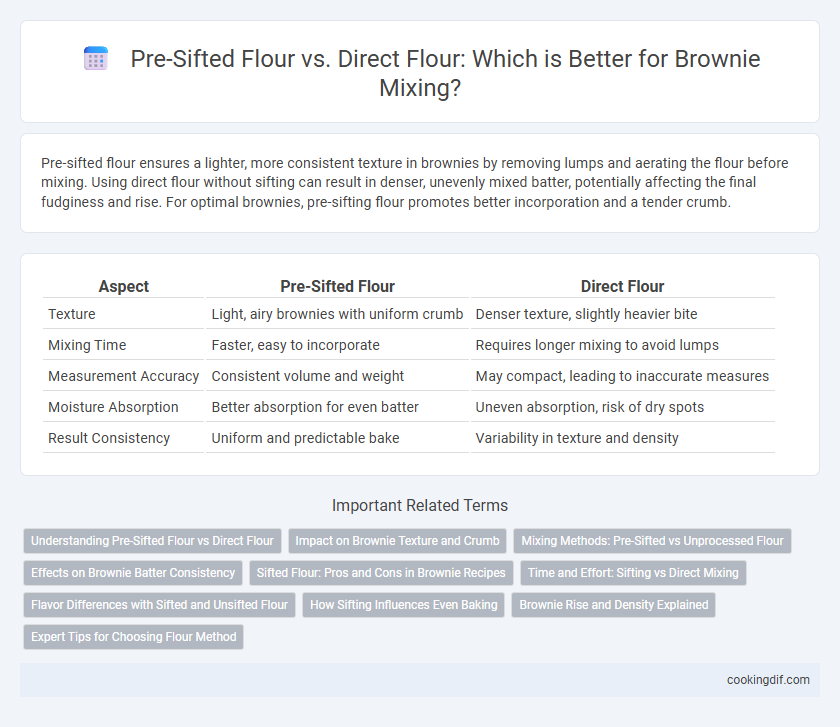Pre-sifted flour ensures a lighter, more consistent texture in brownies by removing lumps and aerating the flour before mixing. Using direct flour without sifting can result in denser, unevenly mixed batter, potentially affecting the final fudginess and rise. For optimal brownies, pre-sifting flour promotes better incorporation and a tender crumb.
Table of Comparison
| Aspect | Pre-Sifted Flour | Direct Flour |
|---|---|---|
| Texture | Light, airy brownies with uniform crumb | Denser texture, slightly heavier bite |
| Mixing Time | Faster, easy to incorporate | Requires longer mixing to avoid lumps |
| Measurement Accuracy | Consistent volume and weight | May compact, leading to inaccurate measures |
| Moisture Absorption | Better absorption for even batter | Uneven absorption, risk of dry spots |
| Result Consistency | Uniform and predictable bake | Variability in texture and density |
Understanding Pre-Sifted Flour vs Direct Flour
Pre-sifted flour has been aerated and separated from clumps, ensuring a consistent texture and accurate measurement, which results in a lighter, more tender brownie crumb. Direct use of unsifted flour can lead to denser brownies due to uneven distribution of flour particles and potential clumping during mixing. Choosing pre-sifted flour enhances the even incorporation of ingredients, improving the overall texture and mouthfeel of homemade brownies.
Impact on Brownie Texture and Crumb
Pre-sifted flour incorporates air and breaks up clumps, resulting in a lighter, more tender brownie with a finer crumb structure. Direct flour, when mixed without sifting, can lead to denser brownies with a coarser crumb due to uneven flour distribution and potential overmixing. Consistent flour aeration through sifting enhances brownie softness and prevents heavy, gummy textures commonly found in unsifted flour mixtures.
Mixing Methods: Pre-Sifted vs Unprocessed Flour
Using pre-sifted flour in brownie mixing ensures even distribution of dry ingredients, resulting in a smoother batter and consistent texture. Directly adding unprocessed flour risks clumping and uneven mixing, which can lead to dense, irregular brownies. Pre-sifting enhances aeration and prevents overmixing, promoting optimal rise and a tender crumb in the final product.
Effects on Brownie Batter Consistency
Using pre-sifted flour in brownie mixing results in a lighter, more aerated batter with improved uniformity, enhancing the final texture. Directly adding flour without sifting often leads to denser batter with potential lumps, negatively affecting the smoothness and rise of brownies. Proper flour integration is crucial for achieving the ideal chewy yet tender consistency desired in brownies.
Sifted Flour: Pros and Cons in Brownie Recipes
Sifted flour in brownie recipes ensures a lighter, more aerated batter, contributing to a tender crumb and even texture. The sifting process helps to remove lumps and incorporates air, promoting better ingredient integration and a uniform rise. However, the extra step can be time-consuming and may lead to slight flour loss, affecting precise measurements if not carefully handled.
Time and Effort: Sifting vs Direct Mixing
Using pre-sifted flour for brownie mixing significantly reduces preparation time and effort by eliminating the need for manual sifting, ensuring a smoother, lump-free batter quickly. Direct mixing with unsifted flour demands extra time to break down clumps and evenly incorporate dry ingredients, often requiring more vigorous stirring. Choosing pre-sifted flour streamlines the process, enhancing efficiency in both home and commercial brownie preparation.
Flavor Differences with Sifted and Unsifted Flour
Using pre-sifted flour in brownie mixing promotes a lighter texture and more even distribution of cocoa, subtly enhancing the chocolate flavor by preventing clumps and ensuring consistent moisture absorption. Directly adding unsifted flour can lead to denser brownies with uneven pockets of flour, which may dull the overall flavor by creating dry spots and inconsistent taste. The choice between pre-sifted and unsifted flour impacts flavor depth and texture, with sifted flour generally producing a richer, more balanced brownie experience.
How Sifting Influences Even Baking
Using pre-sifted flour in brownie mixing ensures consistent particle size, promoting even distribution of ingredients and uniform batter texture. Directly adding flour without sifting can lead to clumps, resulting in uneven baking and pockets of dense brownie. Proper sifting minimizes air pockets and helps achieve a smoother, more cake-like crumb in the finished brownie.
Brownie Rise and Density Explained
Using pre-sifted flour in brownie mixing results in a lighter, more aerated batter, which promotes better rise and a less dense texture. Directly adding flour without sifting tends to compact the batter, producing a denser, fudgier brownie due to uneven flour distribution and potential clumps. The choice between pre-sifted and direct flour significantly impacts the final crumb structure, with pre-sifted yielding a fluffier, more cake-like consistency.
Expert Tips for Choosing Flour Method
Pre-sifted flour ensures even distribution of dry ingredients, reducing the risk of dense or unevenly textured brownies. Directly measuring flour without sifting is faster but may lead to compact brownies due to flour clumps or uneven incorporation. Experts recommend weighing flour for precision and sifting when using all-purpose flour to achieve moist, tender brownies with optimal crumb structure.
Pre-Sifted Flour vs Direct Flour for Brownie Mixing Infographic

 cookingdif.com
cookingdif.com